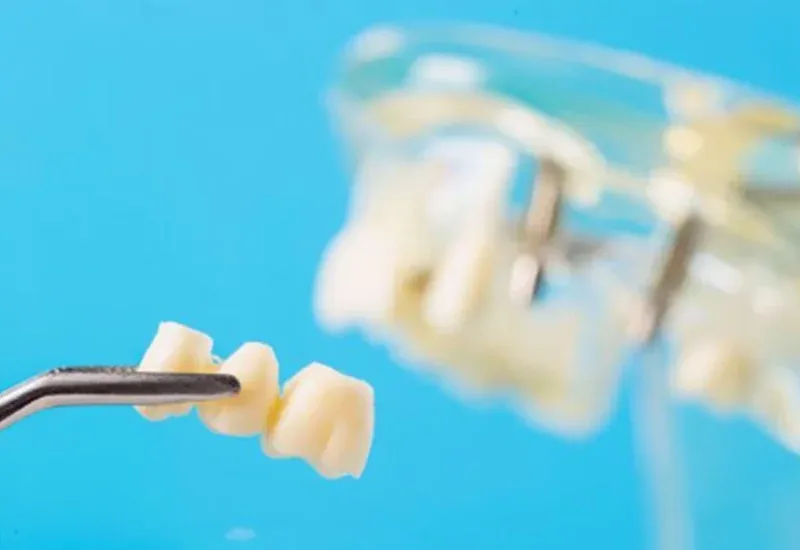
Dental Crowns and Dental Bridges

Dr. Uvika Singh
04 February 2025
If you have one or more missing teeth, your dentist might suggest getting artificial replacements. One option is removable dentures, which you can take out and clean. However, some people find that dentures can move around or even fall out, which can be frustrating.
Another option is to use crowns attached to dental implants or bridges, which feel and function more like your natural teeth. But how do you decide between crowns and bridges? We’re here to help you understand both choices so you can find the best fit for your needs.
What Is a Dental Bridge?
A bridge is a dental treatment that helps replace a missing tooth by using multiple crowns connected together. At its simplest, a bridge has two crowns on either side of a fake tooth called a pontic. The number of teeth covered by a bridge is referred to as the number of units, with the most common being a three-unit bridge, which uses two teeth to support one replacement tooth.
Bridges can be made from the same materials as crowns. Since a bridge connects to your natural teeth, you will need to adjust your oral hygiene routine to keep the supporting teeth healthy.
Getting a bridge is a relatively quick process, usually taking just a few weeks to complete. Once it is ready, the bridge is permanently cemented onto the anchor teeth. So, it cannot be removed by you.
A bridge is a good alternative to a dental implant for replacing a missing tooth.
How Do Tooth Bridges Work?
While crowns are used to fix damaged teeth, a bridge is specifically designed to replace one or more missing teeth. Your dentist will place caps on the filed-down teeth or dental implants at both ends of the gap where the tooth is missing to create a bridge. The replacement teeth, known as pontics, fill the space between these caps.
Just like with crowns, you can choose from different materials for your bridge. Your dentist can help you decide which material is best for you based on your needs. When making this choice, you will want to talk about several factors to your dentist. These factors usually include how visible the tooth will be, the cost, the strength of the materials, and how natural it looks.
Benefits of a Bridge
A bridge is a fast solution for replacing one or two missing teeth. It doesn’t involve any surgery, and most dental insurance plans cover it.
Getting a bridge usually takes two visits to the dentist. In the first visit, the two teeth next to the gap are prepared, similar to how they would be for crowns. You might wear a temporary bridge or two separate temporary crowns while the dental lab makes your bridge. During the second visit, the final bridge is fitted and securely attached to your teeth.
Overall, bridges are a convenient option for restoring your smile.
“Dentistry is not expensive….neglect is!”
What Is Dental Crown?
A “dental crown” is something many people have heard of. Some people also call it a “cap.” In dentistry, the term "crown" actually has two meanings. First, it refers to the part of the tooth that is visible above the gums and bone. This part does not include the roots of the tooth. In a healthy tooth, the crown is covered with enamel, which is the hard outer layer that protects it.
How Do Dental Crowns Work?
A crown is like a cap that completely covers a damaged tooth. It not only strengthens the tooth but can also improve its look, shape, or alignment. Crowns can also be placed on top of dental implants to give them a natural tooth-like appearance and function.
- Crowns can be made from different materials.
- Porcelain or ceramic crowns can be matched to the color of your natural teeth, making them a great choice for front teeth.
Other materials include gold and metal alloys, which are usually stronger and might be recommended for back teeth.
Sometimes, a combination of porcelain and a metal shell is used because it is both strong and attractive.
Your dentist might suggest a crown for several reasons, such as:
- To replace a large filling when there is not enough tooth left
- To fix a fractured tooth
- To protect a weak tooth from breaking
- To hold a bridge in place
- To hide a tooth that is discolored or poorly shaped
- To cover a dental implant
- To cover a tooth that has had a root canal treatment
Crowns are a versatile solution to help restore your smile and keep your teeth healthy.
Why Do Your Teeth Need Dental Crowns?
Teeth need crowns when they are too weak to handle normal chewing on their own. Here are some common reasons why a tooth might need a crown:
Large Decay
If a tooth has a big cavity that has damaged its outer layer (enamel) and inner structure (dentin), it may be too weak to hold a filling. In this case, the dentist can remove the decay, rebuild the tooth, and then place a crown on top to restore its function.
Large Fillings
If a tooth already has a large filling that covers more than half of it, the remaining tooth may not be strong enough for everyday use. A crown can help protect the tooth and improve its chances of lasting longer.

Need any help?
Contact usCracks
Cracks in teeth can be tricky. If a crack doesn’t reach the nerve inside the tooth, a crown can help prevent it from getting worse. The crown acts like a new protective layer, similar to the enamel that covers healthy teeth.
Root Canal Treatment
After a root canal, the tooth becomes dried out and brittle, making it prone to cracking. Placing a crown helps prevent this from happening.
Teeth may need a crown when they are no longer strong enough to withstand normal chewing on their own. There are a few common reasons a tooth might require a crown:
Crowns essentially act as a new, protective outer layer for teeth that have been significantly damaged or weakened. They help restore the tooth's strength and function so you can continue using it for chewing. With proper care, crowns can last 5 to 15 years before needing replacement.
How Long Do Tooth Crowns and Tooth Bridges Last?
Crowns and bridges can last a long time, even a lifetime, but they can sometimes come loose or fall out. To help your crown or bridge last as long as possible, it’s important to take good care of your teeth and gums. If the teeth or bone supporting a bridge get damaged by dental issues, the bridge can lose its support.
To keep your gums and teeth healthy, make sure to brush with fluoride toothpaste twice a day and floss daily. Regular visits to your dentist for checkups and cleanings are also essential.
To avoid damaging your new crown or bridge, try not to chew on hard foods, ice, or other tough objects. Taking these steps can help ensure that your dental work stays in great shape for years to come.
Final Thoughts
Dental crowns and bridges are essential tools in modern dentistry, offering effective solutions for restoring damaged or missing teeth. If you are experiencing dental issues that may require these treatments, it's crucial to consult our dentist at Advanced Dental Concepts of Oakland. They can provide personalized recommendations based on your unique dental needs. It ultimately helps you maintain a healthy and beautiful smile.
Contact your dentist today in Oakland, Dr. Uvika Singh, at Advance Dental Concepts Oakland, to learn more about dental crowns and dental bridges.
Resource:
Share This:
Disclaimer
*This media/content or any other on this website does not prescribe, recommend, or prevent any treatment or procedure. Therefore, we highly recommend that you get the advice of a qualified dentist or other medical practitioners regarding your specific dental condition. *
